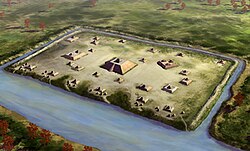Holly Bluff Site

An illustration of what the Holly Bluff Site may have looked like. Artist Herb Roe
|
|
| Location |
Holly Bluff, Mississippi, Yazoo County, Mississippi, |
|---|---|
| Region | Yazoo County, Mississippi |
| Coordinates | 32°48′50.77″N 90°40′58.62″W / 32.8141028°N 90.6829500°W |
| History | |
| Founded | 800 |
| Abandoned | 1500 |
| Periods | Plaquemine Mississippian |
| Cultures | Plaquemine culture |
| Site notes | |
| Excavation dates | 1908, 1928, 1936, 1949, 1958-1960 |
| Archaeologists | Clarence Bloomfield Moore, Philip Phillips, James A. Ford, Paul Gebhard, Nick Zeigler in |
| Architecture | |
| Architectural styles | platform mound |
| Architectural details |
Number of temples: 25 |
|
Holly Bluff Site
|
|
| NRHP Reference # | 66000412 |
| Significant dates | |
| Added to NRHP | October 15, 1966 |
| Designated NHL | July 19, 1964 |
| Responsible body: Private | |
Number of temples: 25
The Holly Bluff Site (22 YZ 557), sometimes known as the Lake George Site, and locally as “The Mound Place,”) is an archaeological site that is a type site for the Lake George phase of the prehistoric Plaquemine culture period of the area. The site is on the southern margin of the Mississippian cultural advance down the Mississippi River and on the northern edge of that of the Cole's Creek and Plaquemine cultures of the South." The site was first excavated by Clarence Bloomfield Moore in 1908 and tested by Philip Phillips, Paul Gebhard and Nick Zeigler in 1949.
It was declared a National Historic Landmark in 1964.
One of the half dozen really big sites in the State of Mississippi, the Holly Bluff Site is located on the south bank of George Lake, or Lake George as it is sometimes known, a half mile east of its confluence with the Sunflower River and a mile and a half southeast of the village of Holly Bluff, Yazoo County. Today the site is bisected by a county road and is used as a plantation headquarters but still clearly visible are the numerous large mounds and the remains of a surrounding wall.
The sites occupation begins with a Jaketown Phase occupation evidenced by a scattering of Poverty Point objects in the lowest levels of excavations. This is followed, after a hiatus evidenced by a complete lack of Tuscola Phase materials, by an early Marksville period component tentatively assigned an early Anderson Landing Phase that may have lasted into an early Issaquena times. The succeeding late Issaquena Phase and Deasonville Phases are virtually unrepresented at Holly Bluff. The site was again occupied from the lower half of the Baytown period up to the late prehistoric times. All phases of the local sequence from the Bayland on through the Lake George Phase (1350-1500)(of which the site is the type site for the Lower Yazoo Basin Plaquemine chronology) are abundantly documented. Materials of the Crippen Point Phase of the Late Coles Creek appear to be most widely spread, and it may have been at this time that the settlement attained its greatest size. In the final Lake George Phase additions were made to some of the mounds, especially Mound A, and the enclosing embankment was built, but the total area occupied was perhaps not as large as in the preceding period.
...
Wikipedia

